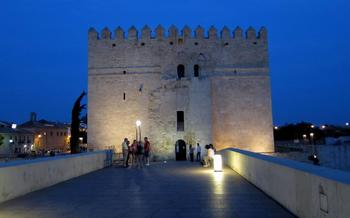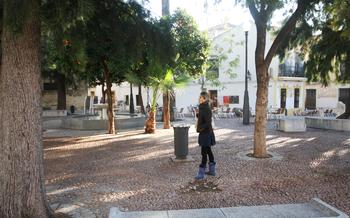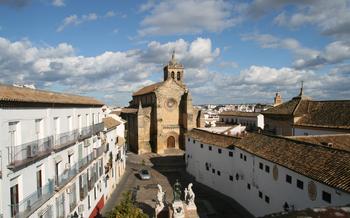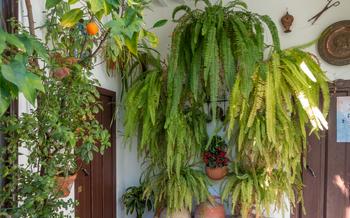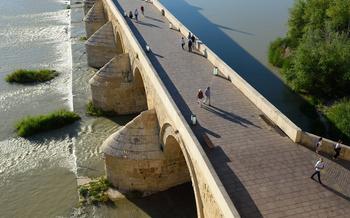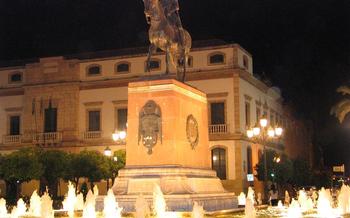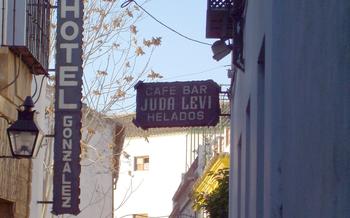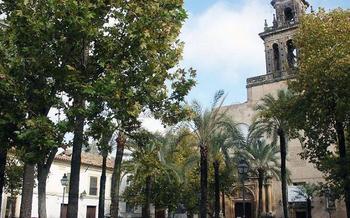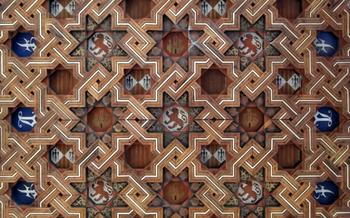
Fuente de Santa Maria
- A City of History
- The Mezquita of Córdoba
- The Alcázar of Córdoba
- The Jewish Quarter
- The Roman Bridge
- A Testament to Roman Engineering
- The Construction of the Bridge and its Importance
- The Islamic Period and the Christian Reconquest
- The Flower Market
- Museo Arqueológico de Córdoba
- The Museo de Bellas Artes de Córdoba
- The Cristo de los Faroles: A Beacon of Faith in Córdoba
- The Feria de Córdoba
- The Gastronomy of Córdoba
- Nightlife in Córdoba
- Shopping in Córdoba
- Insider Tip
A City of History
Córdoba's rich history is evident in its diverse architectural styles, from the Roman bridge to the Gothic churches and the Moorish palaces. The city was founded by the Romans in the 2nd century BC and became the capital of the province of Hispania Baetica. During the Islamic period, Córdoba became one of the most important cities in the Muslim world, and the Umayyad dynasty built the magnificent Mezquita, one of the most iconic landmarks of Spain. After the Reconquista, Córdoba became a Christian city, and the Catholic monarchs added Gothic and Renaissance elements to the Mezquita. The city's Jewish quarter, one of the best-preserved in Europe, dates back to the Middle Ages.
The Mezquita of Córdoba
The Mezquita of Córdoba, also known as the Great Mosque of Córdoba, is one of the most iconic landmarks of Spain and a UNESCO World Heritage Site. It is a testament to the city's rich history and the blending of different cultures.
The mosque was built by the Umayyad dynasty in the 8th century, as the capital of the Islamic province of Al-Andalus. It was originally a small mosque, but it was gradually expanded over the centuries, becoming one of the largest mosques in the world.
The mosque is an architectural masterpiece, with a unique blend of Islamic and Gothic elements. The interior of the mosque is simply breathtaking, with its rows of columns, arches, and domes. The highlight of the mosque is the mihrab, a niche that indicates the direction of Mecca. It is made of gold and silver, and it is one of the most beautiful examples of Islamic art.
In the 13th century, after the Christian reconquest of Córdoba, the mosque was converted into a cathedral. The Christians added a number of Gothic elements to the mosque, including the bell tower and the choir. The result is a unique blend of Islamic and Christian architecture that is unlike anything else in the world.
The Alcázar of Córdoba
The Alcázar of Córdoba is a royal palace with a rich and varied history. The palace was originally built by the Romans in the 1st century BC, and it was later expanded by the Visigoths in the 6th century AD. During the Islamic period, the Alcázar was used as the residence of the emirs and caliphs of Córdoba, and it was further expanded and embellished. After the Christian reconquest of Córdoba in 1236, the Alcázar was used as a royal palace by the Christian kings of Castile. The palace was extensively renovated in the 14th and 15th centuries, and it was given its present appearance by the Catholic Monarchs, Ferdinand and Isabella, in the late 15th century.
The Alcázar of Córdoba is a beautiful example of Spanish Renaissance architecture, and it is one of the most popular tourist attractions in the city. The palace is home to a number of important works of art, including a collection of Roman mosaics, a series of 16th-century tapestries, and a number of paintings by Spanish masters such as El Greco and Velázquez. The Alcázar is also known for its beautiful gardens, which are filled with flowers, trees, and fountains.
The Alcázar of Córdoba is a must-see for any visitor to the city. The palace is a beautiful and historic building, and it is a great place to learn about the history of Córdoba.
The Jewish Quarter
Córdoba's well-preserved Jewish Quarter, known as the Judería, is a testament to the city's rich cultural heritage. The Jewish community has played a significant role in the history of Córdoba, dating back to the Roman period. During the Islamic era, the Jews enjoyed a period of relative tolerance and prosperity, and the Judería became a thriving center of Jewish life.
The history of the Jewish community in Córdoba is a complex and fascinating one. The Jews were first expelled from the city in the 11th century, but they were allowed to return in the 13th century. They were finally expelled again in the 15th century, and the Judería was largely abandoned. However, in recent years, the Judería has been restored and revitalized, and it is now one of the most popular tourist attractions in Córdoba.
The synagogue and the Jewish cemetery are two of the most important landmarks in the Judería. The synagogue is one of the oldest in Spain, and it has been beautifully restored. The Jewish cemetery is also a fascinating place to visit, with its rows of ancient tombstones.
The Jewish Quarter is a vibrant and lively area, with narrow streets, whitewashed houses, and flower-filled balconies. It is a great place to wander around and soak up the atmosphere of Córdoba's past. There are also a number of shops and restaurants in the Judería, where you can buy souvenirs or enjoy a traditional Spanish meal.
The Roman Bridge
A Testament to Roman Engineering
The Roman Bridge is one of the most iconic landmarks of Córdoba. It spans the Guadalquivir River and connects the historic center of the city with the modern district. The bridge was built by the Romans in the 1st century BC and is one of the best-preserved Roman bridges in the world. It is also one of the longest bridges of its kind, measuring over 250 meters.
The bridge is made of large granite blocks and has 16 arches. It was built to withstand the strong currents of the Guadalquivir River, and it has survived many floods and earthquakes over the centuries. The bridge was renovated several times over the years, but its basic structure remains the same.
The Construction of the Bridge and its Importance
The Roman Bridge was built as part of a major road that connected the Roman province of Hispania Baetica with the rest of the Roman Empire. The bridge was an important strategic and economic asset, as it allowed for the easy movement of goods and people across the Guadalquivir River.
The Roman Bridge was also a symbol of Roman power and prestige. It was one of the most impressive structures in the province of Hispania Baetica, and it demonstrated the engineering prowess of the Romans. The bridge was also a popular tourist attraction, and it was visited by many people from all over the Roman Empire.
The Islamic Period and the Christian Reconquest
The Roman Bridge remained in use throughout the Islamic period and the Christian reconquest. The Islamic rulers of Córdoba repaired and maintained the bridge, and they used it to transport goods and troops across the river. The Christian rulers of Córdoba also used the bridge, and they made repairs and improvements to it.
The Roman Bridge is a testament to the engineering skills of the Romans. It is a beautiful and impressive structure that has survived for over 2,000 years. The bridge is a reminder of the importance of Córdoba in Roman times, and it is a symbol of the city's rich history.
Insider Tip:
The Roman Bridge is a great place to watch the sunset. The bridge offers stunning views of the Guadalquivir River and the city of Córdoba.
The Flower Market
The Flower Market, set against the backdrop of the stunning Guadalquivir River, is a riot of colors and fragrances that has enthralled locals and visitors alike for centuries. Its origins can be traced back to the 16th century when it was established as a place for flower sellers to gather and trade their vibrant blooms. Over the years, the market has grown in size and reputation, becoming one of the most popular attractions in Córdoba.
The market is a treasure trove of floral delights, with vendors showcasing a dazzling array of flowers from all over the region. From delicate roses and fragrant lilies to vibrant geraniums and exotic orchids, there's something to suit every taste and preference. The air is filled with the sweet scent of jasmine, lavender, and orange blossoms, creating an intoxicating atmosphere that captivates the senses.
In addition to its visual and olfactory appeal, the Flower Market is also a hub of social interaction. Locals and tourists alike come here to stroll among the colorful stalls, admire the beautiful flowers, and engage in lively conversations with the friendly vendors. It's a place where people from all walks of life come together to share their love of nature and the beauty of flowers.
Museo Arqueológico de Córdoba
The Museo Arqueológico de Córdoba is a museum that houses a vast collection of artifacts from Córdoba's past. The museum was founded in 1844 and has since grown to become one of the most important archaeological museums in Andalusia.
The museum's collection includes artifacts from all periods of Córdoba's history, from the prehistoric era to the Islamic period. There are also a number of exhibits on the city's Roman and Visigothic past, as well as the Christian era.
The museum is a great place to learn about Córdoba's rich history and culture. The exhibits are well-organized and informative, and the museum staff is friendly and helpful.
Highlights of the Collection
Some of the highlights of the museum's collection include:
- A collection of prehistoric tools and weapons
- A Roman mosaic depicting a scene from the Trojan War
- A Visigothic gold crown
- An Islamic ceramic bowl with a calligraphic inscription
- A Christian statue of the Virgin Mary from the 13th century
The Museo Arqueológico de Córdoba is a must-see for anyone interested in the history and culture of Córdoba. The museum is located in the city center, near the Mezquita.
The Museo de Bellas Artes de Córdoba
The Museo de Bellas Artes de Córdoba is one of the most important art museums in Andalusia. It is located in the Plaza del Potro, in the historic center of the city. The museum was founded in 1844 and its collection includes paintings, sculptures, and drawings from the 14th to the 21st centuries.
The museum's collection of paintings is particularly impressive, with works by some of the most famous Spanish artists, such as El Greco, Zurbarán, and Murillo. There is also a large collection of works by contemporary Spanish artists, such as Picasso, Dalí, and Miró.
The sculpture collection at the Museo de Bellas Artes de Córdoba is also significant, with works by some of the most important Spanish sculptors, such as Alonso Cano, Juan de Mesa, and Pedro de Mena. There is also a large collection of contemporary sculptures, including works by Eduardo Chillida, Jorge Oteiza, and Antoni Tàpies.
The Museo de Bellas Artes de Córdoba is a must-see for any art lover visiting the city. The museum's collection is vast and varied, and there is something for everyone to enjoy.
The Cristo de los Faroles: A Beacon of Faith in Córdoba
In the heart of Córdoba's historic center, a statue of Jesus Christ stands as a beacon of faith and devotion. Known as the Cristo de los Faroles, or Christ of the Lanterns, this iconic sculpture has become a symbol of the city and a popular pilgrimage site for believers from around the world.
The history of the Cristo de los Faroles dates back to the 17th century. According to legend, a group of criminals were caught attempting to rob a church. In their desperation, they sought refuge in the ruins of an old Roman temple. As they hid in the shadows, they heard a voice calling out to them, urging them to repent and turn away from their sinful ways.
The criminals were so moved by the voice that they decided to change their lives. They abandoned their criminal activities and dedicated themselves to serving the poor and needy. As a symbol of their transformation, they erected a statue of Jesus Christ on the site where they had heard the voice.
The statue quickly became a popular pilgrimage site, and people from all over the region flocked to Córdoba to pray before it. Over the centuries, the Cristo de los Faroles has become one of the most beloved and revered religious icons in Spain.
Every year, on the first Sunday of May, a grand pilgrimage is held in honor of the Cristo de los Faroles. Thousands of people gather in Córdoba to participate in the procession, which winds its way through the city's narrow streets. The statue is carried on a float, adorned with flowers and candles, and the air is filled with the sound of music and prayer.
The Cristo de los Faroles is a powerful symbol of faith and redemption, and its annual pilgrimage is a testament to the enduring power of religion in Spanish culture.
The Feria de Córdoba
The Feria de Córdoba is one of the most important festivals in Spain. It is a week-long celebration that takes place every year in May. The festival is a time for people to come together and celebrate the city's culture and traditions.
The Feria de Córdoba has its origins in the Middle Ages, when it was a livestock fair. Over the years, the festival has evolved into a much larger and more elaborate event. Today, the Feria de Córdoba is a major tourist attraction, and it draws visitors from all over the world.
The festival is centered around a large fairground that is located on the outskirts of the city. The fairground is filled with tents, where people can eat, drink, and dance. There are also a number of rides and attractions, as well as live music performances.
One of the highlights of the Feria de Córdoba is the bullfights. Every day, there are several bullfights that are held in the city's bullring. The bullfights are a controversial tradition, but they are still very popular with many people.
The Feria de Córdoba is a great time to experience the culture and traditions of Córdoba. It is a vibrant and colorful festival, and it is a great opportunity to meet new people and make new friends.
The Gastronomy of Córdoba
The gastronomy of Córdoba is a unique blend of Mediterranean and Moorish influences, reflecting the city's rich history and cultural heritage. Some of the most typical dishes of Córdoba include salmorejo, a cold tomato soup similar to gazpacho but thicker and creamier; flamenquín, a fried pork roll stuffed with ham and cheese; and rabo de toro, a stew made with bull's tail. For those with a sweet tooth, Córdoba is also known for its pastel cordobés, a flaky pastry filled with sweet potato, cinnamon, and orange zest.
Córdoba is also home to a number of traditional tapas bars, where you can sample a variety of small dishes and drinks. Some of the most popular tapas include berenjenas con miel, fried eggplant drizzled with honey; croquetas, fried balls of ham, cheese, or fish; and patatas bravas, fried potatoes topped with a spicy tomato sauce.
When it comes to restaurants, Córdoba has something to offer everyone, from traditional Spanish cuisine to international fare. Some of the most popular restaurants in Córdoba include Casa Pepe de la Judería, a traditional Spanish restaurant serving classic dishes like salmorejo and flamenquín; Taberna Salinas, a tapas bar with a modern twist; and La Botana, a restaurant serving innovative Mediterranean cuisine.
So, whether you're looking for a traditional Spanish meal, a quick tapas snack, or a fine dining experience, Córdoba has something to satisfy your taste buds.
Nightlife in Córdoba
Córdoba's nightlife scene is as vibrant and diverse as the city itself. Whether you're looking for a relaxed evening with friends or a night of dancing and revelry, you're sure to find something to your liking in this historic city.
The city center is home to a variety of bars and clubs, each with its own unique atmosphere. If you're looking for a lively night out, head to the Plaza de las Tendillas, where you'll find a variety of bars and nightclubs playing everything from top 40 hits to traditional Spanish music. If you're looking for something a little more relaxed, try one of the many tapas bars in the Jewish Quarter, where you can enjoy a glass of wine and some traditional Spanish cuisine.
For live music, head to the Tablao El Cardenal, where you can see traditional flamenco dancing, or to the Sala La Bóveda, which hosts a variety of live music events, from rock and pop to jazz and blues.
No matter what your taste, you're sure to find something to your liking in Córdoba's vibrant nightlife scene. So put on your dancing shoes and get ready to experience the best that Córdoba has to offer!
Shopping in Córdoba
Córdoba is a great city for shopping, with a wide variety of shops and markets to choose from. The city center is home to many traditional Spanish shops, where you can find everything from souvenirs to clothing to antiques. For a more unique shopping experience, head to the Zoco Municipal market, where you can find a variety of handmade goods, as well as fresh produce and spices.
If you are looking for traditional Spanish products, such as olive oil, wine, and cheese, head to the Mercado Central de Abastos, a bustling market where you can find all sorts of fresh and local produce. For a more relaxed shopping experience, take a stroll along the Guadalquivir River, where you will find a number of shops and boutiques selling everything from clothing to jewelry to home goods.
No matter what you are looking for, you are sure to find it in Córdoba. The city has something to offer everyone, from traditional Spanish souvenirs to unique handmade goods.
Insider Tip
If you are planning a visit to Córdoba, one insider tip is to avoid visiting during the summer months. The summers in Córdoba can be scorching, with temperatures often reaching into the 40s (°C). This can make it difficult to enjoy the city's many attractions, as walking around in the heat can be draining. Instead, the best time to visit Córdoba is during the spring or fall when the weather is mild. The spring (April-May) and fall (September-October) months offer pleasant temperatures, making it ideal for exploring the city's streets, squares, and patios. During these months, the city is also less crowded with tourists, so you can enjoy a more relaxed and authentic experience.
